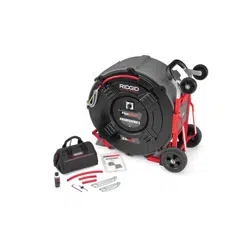Loading ...
Loading ...
Loading ...

K9-306 FlexShaft
TM
Drain Cleaning Machine
999-995-214.10_REV. D
12
Installation of brushes is similar to the instal-
lation of chain knockers. The collar of the
brush is placed over the cable and retained
by securely tightening the set screws. When
at the end of the cable, the cable end is flush
with the brush collar. Brush securing rings
are available to improve brush retention if set
screws loosen in use.
As with chain knockers, minimize the amount
of exposed cable (cable not covered by
sheath). The more exposed cable there is, the
more likely the cable will flip over in use and
be damaged. Limit exposed cable to no more
than ¼" (6 mm), set with a bushing made from
sheath (“Knocker Bushing”).
Installing Penetrating Head
Penetrating heads are available to help create
a hole in a blockage to get the drain flowing
and allow the chain knocker into an area. See
Figure 9 for installation information.
Figure 9 – Penetrating Head Installation
Operating Instructions
WARNING
Always use safety glasses and gloves in good
condition while handling or using. Use latex or
rubber gloves, face shields, protective clothing,
respirators or other appropriate protective equip-
ment when chemicals, bacteria or other toxic or
infectious substances are suspected to be present
to reduce the risk of infections, burns or other
serious personal injury.
Do not allow the chain knocker/end of cable to
stop turning while cable assembly is turning.
This can overstress the cable and may cause
twisting, kinking or breaking of the cable assembly
and may result in serious personal injury.
Keep a hand on the cable assembly whenever
the FlexShaft Machine is running. This provides
better control of the cable and helps prevent twist-
ing, kinking and breaking of the cable and reduces
the risk of injury.
Position the FlexShaft Machine cable outlet
within 4' (1.2 m) of the drain inlet or properly
support exposed cable assembly when the dis-
tance exceeds 4' (1.2 m). Greater distances can
cause control problems leading to twisting, kinking
or breaking of the cable. Twisting, kinking or break-
ing cable may cause striking or crushing injuries.
One person must control both the cable as-
sembly and foot switch. If the cable stops rotat-
ing, the operator must be able to turn the tool OFF
to prevent twisting, kinking and breaking of the
cable and reduce the risk of injury.
Follow operating instructions to reduce the
risk of injury from twisted or broken cable,
cable ends whipping around, machine tipping,
chemical burns, infections and other causes.
1. Make sure that machine and work area is
properly set-up and that the work area is
free of bystanders and other distractions.
2. Pull cable assembly from the machine
and feed into drain. At least 1' (0.3 m) of
cable must be in drain so that the chain
knocker will not come out of the drain and
whip around when the machine is started.
Directly route the cable assembly from
the machine cable outlet to the drain
opening, minimizing exposed cable and
changes in direction. Do not tightly bend
the cable assembly – this can increase
the risk of twisting or breaking.
If using a camera to view the drain clean-
ing process, the camera can be fed in
at the same time. Typically the cable as-
sembly and the camera push rod can be
gripped and advanced/retrieved at the
same time. Keep the camera at least 1.5’
( 0.5 m) behind the chain knocker.
Do not allow the spinning chain
knocker to hit the camera head/push rod.
It can damage it.
3. Assume a proper operating position to
help maintain control of the cable assem-
bly and machine (see Figure 10):
• Be sure you can quickly release the
foot switch.
• Your gloved hands must be on the ca-
ble assembly to control and support as
the cable assembly is fed into the drain
and blockage.
Collar
Fully Insert
Securely Tighten
Set Screws
1/4" (6mm) MAX.
NOTICE
Always use safety glasses and gloves in good condition while
handling or using. Use latex or rubber gloves, face shields,
protective clothing, respirators or other appropriate protective
equip- ment when chemicals, bacteria or other toxic
or infectious substances are suspected to be present to
reduce the risk of infections, burns or other serious personal
injury. Do not allow the chain knocker/end of cable to
stop turning while cable assembly is turning. This can overstress
the cable and may cause
Loading ...
Loading ...
Loading ...
